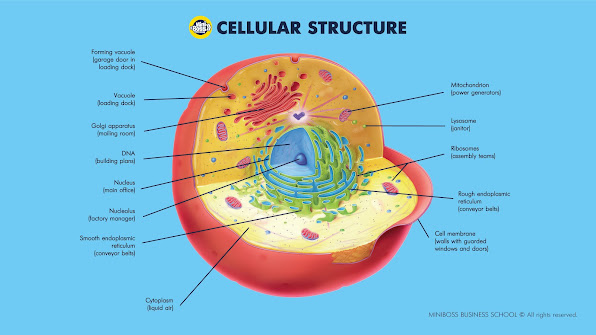An excerpt from the book by the famous entrepreneur and innovator Dr. Olga Azarova "FULL HUMAN POTENTIAL: EIGHT INTELLIGENCES" will give us a clear understanding of the concept of "living", because this preface to understanding the MINIBOSS BUSINESS SCHOOL Methodology reveals to us a vision of what life is and what education should be in order to manage it for our own benefit and the benefit of the Planet.

A little science wouldn't hurt us all, right?
Yes, life is a pleasant journey that we want to extend forever. Moreover, something can be "lengthened" and something "shortened" along the way. That is, life, its quality and duration, can be consciously influenced if you understand three things:
- Who we are and where we came from (which macrosystem we belong to),
- How we function (what and how ensures our survival),
- How to manage your body and, accordingly, life (where and why to go).
FROM 20 TO 70 YEARS
Not indefinitely, of course, but we can influence processes and their results, to a large extent we can. And while scientists around the world are studying how to extend human life and make it immortal, let's remember that much has already been done - the average lifespan of a Neanderthal was 20 years, of a primitive man homo sapiens 30-35 years, of a medieval man the same 35 years, and only scientific progress of the 17-18 centuries extended our life to 50-60 years, and today - on average to 70-70 years.
Although there are a number of factors that shorten life - wars, epidemics, diseases, hunger, poor ecology, stress, but if you are "armed" with the knowledge of how to control your fighting machine - the body - then life seems not to be suffering or a series of fatal accidents, but a ship of happiness and pleasure consciously controlled by you. Yes, in this sea of life there will be storms, whirlpools, and even "pirates", but you can withstand the onslaught of the elements and digest various defeats and hardships if you understand what you have already gained and what may await you beyond the horizon, what is the price of victories and defeats in each of the battles of life.
Question No. 1.
Are you alive?
You know, not all readers will answer "yes" even to this simple question. Some may get stuck in the awareness of what is happening now/past and answer "I don't know" "halfway" or "is this life?" This can only happen if a person does not live consciously, does not study and comprehend the world and himself and therefore does not know what his body, spirit and mind are striving for. Without fulfilling a large share of the functions of their potential, even during their entire life, many people die, saying, "is this life?"
Question No. 2.
Do you want to know what your personal potential is?
If you answered the question in the affirmative, then you are lucky - you intend not only to study yourself and the world, but also to act. In this case, this book will become your Personal Book of Life - your personal Bible/Koran/Torah/Veda, which you will reread hundreds of times and each time find new answers, insights and motives for the flourishing of your life, yes, such a relatively short, but beautiful and meaningful life!
To do this, in the eight books of the cycle "FULL POTENTIAL OF A HUMAN" according to the method of Olga Azarova, you will study each element of potential separately, each intellect separately, and you will study each topic holistically and comprehensively. And in this first book, the task is to understand life itself, its belonging to macro and microsystems, general laws of life, and your individual life in understanding your potential. This will be the greatest wealth - the perception of yourself in this world.
So, what is life?...
Life is an active form of existence of matter, which necessarily contains all the "properties of the living". The concept of "life" can only be defined by listing the qualities that distinguish it from non-life. So, let's highlight the characteristics of living organisms:
1. Cellular structure (life does not exist outside the cell; viruses exhibit the properties of living matter only after the transfer of genetic material into the cell).
2. Similarity of chemical composition (Carbon (C), Oxygen (O), Hydrogen (H), Nitrogen (N) - 98% of all matter. Carbohydrates, proteins, fats and nucleic acids are the main components of living things.
3. Metabolism and energy conversion (nutrition + respiration + excretion) ensure the growth, work and restoration of cells and organs. Nutrition is the process of obtaining nutrients from the environment (for example, water + carbon dioxide + light = photosynthesis = carbohydrates + oxygen).
Respiration is the process of oxygen absorption with the release of energy and the release of carbon dioxide (oxygen - carbon dioxide - energy). Excretion is the removal of decay products from the body.
5. Irritability is the ability of an organism to selectively react to environmental irritation. For example, nasties are indefinite movements of plant organs when exposed to the environment (temperature, light, humidity, etc.), tropisms are the movement of a body part in a certain direction, taxis are the movement of the entire body, reflexes – perception of irritation and involuntary response.
6. Movement – change in body position relative to other bodies over time.

7. Behavior – the ability of living organisms to change their actions under the influence of internal and external factors. Behavior has a huge adaptive value, allowing animals to avoid negative environmental factors. In multicellular organisms, behavior is controlled by the nervous system.
Plants and bacteria also have the ability to actively and orderly move under the influence of external factors (taxis). Examples include photo- and chemotaxis of bacteria and blue-green algae.
Higher plants are also not devoid of the ability to move. Nyctinasty of plants is well known – opening and closing of flowers in connection with the change of day and night, phototropism of leaves, plant movements when hunting animals, hydro- and chemotropism of roots.
However, since the mechanisms of plant movement are purely physiological in nature, it is impossible to speak of their having either behavior or psyche. In psychology, plant movements are attributed to the pre-psychic level of reflection.
8. Reproduction – reproduction of their own kind (all living things reproduce).
9. Heredity – the property of living organisms to pass on to their descendants the features of their structure and functioning. The main attribute of living matter is the genetic information necessary for each living organism for replication, which is initially revealed in a new body at birth, is contained in chromosomes, and is passed on from each individual to descendants. GENOTYPE – a set of genes of an organism.
10. Growth and increase in mass caused by reproduction.
11. Adaptation – adaptation of organisms to the external environment.
12. Variability and Development – acquisition of new features of structure and life processes, new individual abilities. PHENOTYPE is a set of properties and characteristics of an organism that are the result of the interaction of the individual's genotype and the environment.
13. Homeostasis is self-regulation as a property of all living organisms.
14. Discreteness and integrity. Everything in nature is divisible into parts - any biosystem consists of separate but interconnected elements. At the same time, all elements are united, work as a whole and are subject to general laws.
15. The level organisation of living systems reflects the subordination, hierarchy of the structural organisation. For example, a virus exists as an RNA molecule enclosed in a protein shell. This is the form of existence of a virus. However, the mode of its existence (when it exhibits the properties of a living system) is entering the cell of another organism and reproducing in it by feeding on another cell - parasitism.
16. Evolution is an irreversible directed change/development of living nature, accompanied by a change in the genetic composition of the population, the formation and extinction of species, the transformation of biogeocenoses and the biosphere as a whole.
Checking your understanding. Now, to check the correctness of your assimilation of the characteristics of living systems, insert the missing words in the diagram.
Life is determined by characteristics, but we can also say that life is a characteristic of the state of the organism; that is, how alive you are is determined by how much of your potential, given to you by nature, you live.
For this, at the next International Retreat in the Maldives, we will consider human potential as a whole and in its individual elements.















